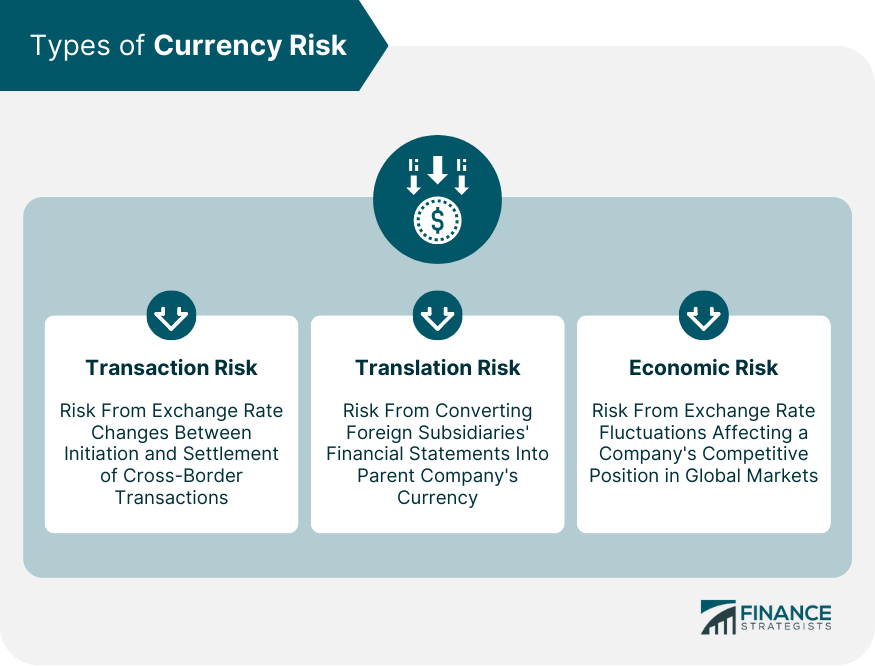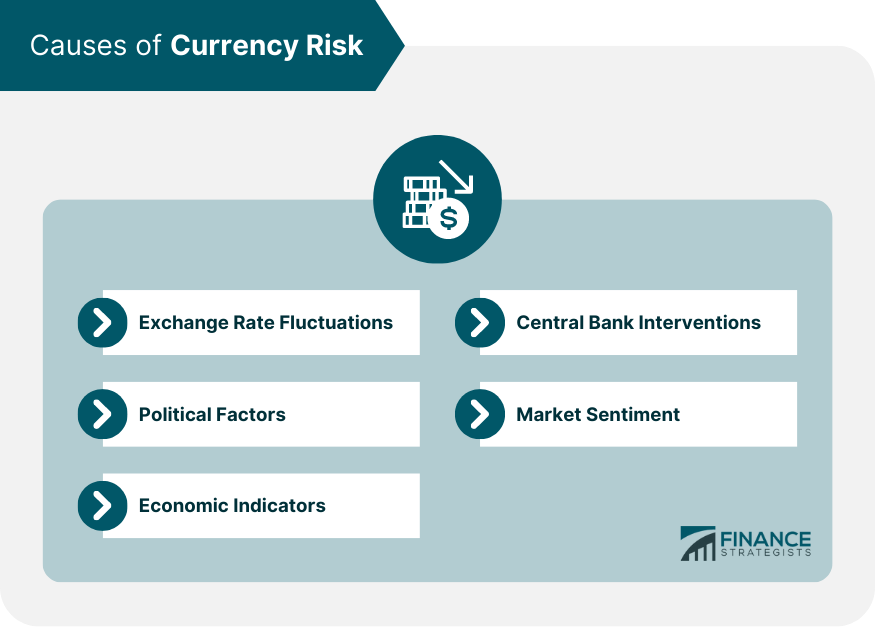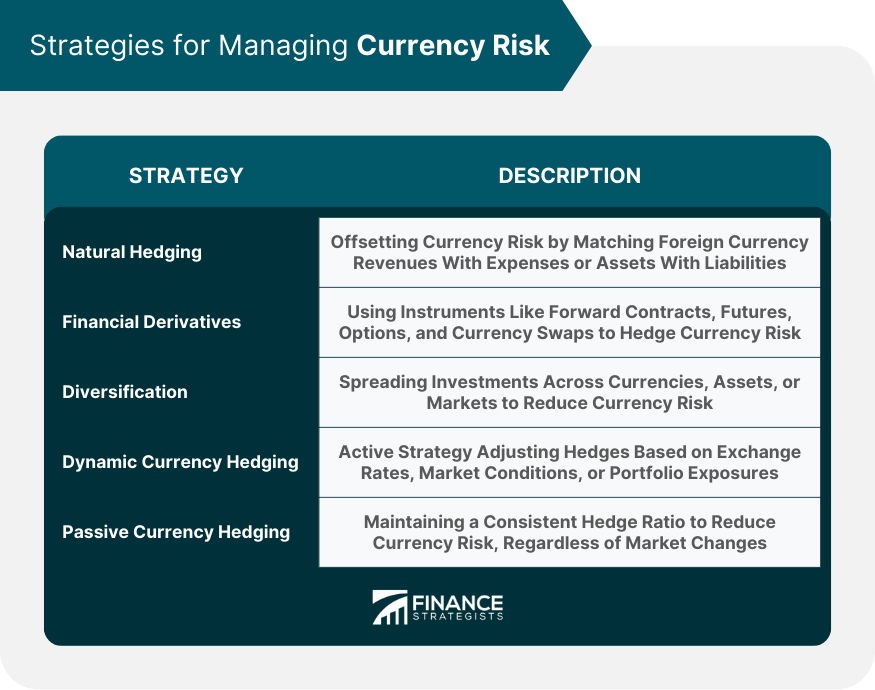Currency risk, also known as exchange rate risk or foreign exchange risk, refers to the potential financial losses resulting from changes in exchange rates. This risk affects businesses and individuals engaged in international transactions, as fluctuations in exchange rates can impact the value of assets, liabilities, and cash flows. Understanding currency risk is essential for businesses and investors involved in international trade or investments. Proper management of currency risk can help minimize potential losses and enhance profitability. Furthermore, understanding currency risk enables businesses to develop effective strategies to mitigate the impact of exchange rate fluctuations on their operations. Several factors contribute to currency risk, including market forces, economic indicators, geopolitical events, and central bank policies. These factors can lead to exchange rate fluctuations, which may impact the value of cross-border transactions, foreign investments, and the competitiveness of businesses operating in global markets. Transaction risk is the risk arising from changes in exchange rates between the initiation and settlement of a cross-border transaction. This type of risk affects businesses that buy or sell goods and services in foreign currencies, as changes in exchange rates can impact the cost of transactions and, subsequently, profit margins. Translation risk, also known as accounting risk, is associated with the process of converting financial statements of foreign subsidiaries into the parent company's reporting currency. Fluctuations in exchange rates can lead to changes in the reported value of assets, liabilities, and income, potentially affecting a company's financial position and performance. Economic risk, also known as competitive or operating risk, refers to the potential impact of exchange rate fluctuations on a company's competitive position in the global market. Changes in exchange rates can affect the cost structure, pricing, and overall profitability of a company, which may influence its ability to compete effectively in international markets. Exchange rate fluctuations are the primary cause of currency risk. These fluctuations can be driven by various factors, such as differences in interest rates, inflation rates, and economic growth between countries. Exchange rate movements can be unpredictable and volatile, making it challenging for businesses and investors to forecast and manage currency risk effectively. Political factors, such as changes in government policies, political instability, and international relations, can influence exchange rates and contribute to currency risk. For example, trade disputes, economic sanctions, or political tensions can lead to increased exchange rate volatility, impacting businesses and investors with exposure to foreign currencies. Economic indicators, such as GDP growth, employment data, and inflation rates, can influence exchange rates and contribute to currency risk. Positive or negative economic data can lead to changes in market expectations and investor sentiment, affecting the demand and supply of different currencies in the foreign exchange market. Central banks play a crucial role in managing exchange rates and can contribute to currency risk. Through monetary policy actions, such as adjusting interest rates or engaging in foreign exchange interventions, central banks can influence exchange rates and create uncertainty for businesses and investors with foreign currency exposure. Market sentiment, driven by factors such as investor confidence, risk appetite, and expectations about future economic conditions, can influence exchange rates and contribute to currency risk. Changes in market sentiment can lead to shifts in capital flows, affecting the demand and supply for different currencies and causing fluctuations in exchange rates. Value at Risk (VaR) is a statistical measure that estimates the maximum potential loss of a portfolio or investment over a given time horizon and confidence level. VaR helps businesses and investors quantify currency risk exposure and assess the potential impact of exchange rate fluctuations on their financial positions. Standard deviation is a measure of the dispersion or variability of exchange rate returns, providing an estimate of the degree of currency risk. A higher standard deviation indicates a higher level of risk, as it signifies that exchange rates are more likely to experience significant fluctuations. Conditional Value at Risk (CVaR), also known as Expected Shortfall (ES), is a risk measure that estimates the average loss in the worst-case scenarios beyond the VaR level. CVaR provides a more comprehensive view of the tail risk associated with currency exposure, helping businesses and investors better understand the potential magnitude of losses in extreme market conditions. Sensitivity analysis is a technique used to assess the impact of changes in exchange rates on a portfolio, investment, or business operation. By examining how different currency scenarios affect the value of assets, liabilities, and cash flows, sensitivity analysis can help identify potential vulnerabilities and guide risk management strategies. Natural hedging is a strategy that involves offsetting currency risk by matching foreign currency revenues with foreign currency expenses or assets with liabilities. By minimizing net exposure to foreign currency fluctuations, businesses can reduce the potential impact of exchange rate changes on their financial position and performance. Financial derivatives are instruments that can be used to hedge currency risk by entering into contractual agreements that lock in exchange rates or provide protection against adverse exchange rate movements. Common types of financial derivatives used for currency risk management include forward contracts, futures contracts, options contracts, and currency swaps. Forward contracts are agreements between two parties to exchange a specified amount of one currency for another at a predetermined exchange rate on a future date. These contracts enable businesses and investors to lock in exchange rates, providing certainty and reducing the risk associated with currency fluctuations. Futures contracts are standardized forward contracts traded on exchanges, which require the parties to buy or sell a specific amount of a currency at a predetermined exchange rate on a future date. Futures contracts offer greater liquidity and price transparency compared to forward contracts but may not be as customizable to meet specific hedging needs. Options contracts give the holder the right, but not the obligation, to buy or sell a specified amount of a currency at a predetermined exchange rate before or on a future date. Options contracts provide flexibility in managing currency risk, as they allow the holder to benefit from favorable exchange rate movements while limiting losses from unfavorable changes. Currency swaps are agreements between two parties to exchange principal and interest payments in different currencies over a specified period. These swaps can be used to manage currency risk by aligning cash flows with foreign currency exposures, effectively hedging against exchange rate fluctuations. Diversification is a strategy that involves spreading investments across different currencies, assets, or markets to reduce currency risk. By investing in a diverse range of assets, businesses and investors can mitigate the impact of exchange rate fluctuations on their overall financial position and performance. Dynamic currency hedging is an active risk management strategy that involves adjusting currency hedges based on changes in exchange rates, market conditions, or portfolio exposures. This approach can help businesses and investors optimize their currency risk management, taking advantage of favorable market opportunities while maintaining a desired level of protection against adverse exchange rate movements. Passive currency hedging is a risk management strategy that involves maintaining a consistent hedge ratio, regardless of changes in exchange rates or market conditions. This approach aims to reduce currency risk by providing a stable level of protection against exchange rate fluctuations without attempting to capitalize on short-term market opportunities. Currency risk can significantly impact international trade, as fluctuations in exchange rates can affect the competitiveness of exports and imports, leading to changes in trade balances and economic growth. Proper management of currency risk is essential for businesses engaged in cross-border transactions to maintain profitability and protect against potential losses. Currency risk can influence foreign direct investment (FDI) decisions, as exchange rate fluctuations can impact the value of assets and earnings, affecting the attractiveness of investment opportunities. Managing currency risk is crucial for businesses and investors considering FDI, as it can help mitigate the impact of exchange rate changes on the overall investment return. Currency risk affects portfolio investments, as fluctuations in exchange rates can alter the value of foreign assets and the returns on those investments. Effective currency risk management is essential for investors with international exposure, as it can help protect against potential losses and enhance overall portfolio performance. Currency risk can have significant implications for financial markets, as exchange rate fluctuations can influence asset prices, interest rates, and capital flows. Proper management of currency risk can help maintain stability in financial markets, supporting economic growth and investor confidence. Currency risk is a critical aspect of international trade and investment that businesses and investors must navigate to minimize potential losses and enhance profitability. Understanding the types and causes of currency risk, as well as the measurement and management strategies, is essential to develop effective risk management plans. Proper management of currency risk can help businesses and investors protect against adverse exchange rate movements and optimize investment returns. Furthermore, the implications of currency risk on global business, including effects on international trade, foreign direct investment, portfolio investment, and financial markets, highlight the need for effective risk management in today's interconnected world. By implementing appropriate strategies and staying informed about market trends, businesses and investors can navigate currency risk successfully and achieve their global business objectives.What Is Currency Risk?
Types of Currency Risk
Transaction Risk
Translation Risk
Economic Risk

Causes of Currency Risk
Exchange Rate Fluctuations
Political Factors
Economic Indicators
Central Bank Interventions
Market Sentiment

Measuring Currency Risk
Value at Risk (VaR)
Standard Deviation
Conditional Value at Risk (CVaR)
Sensitivity Analysis
Strategies for Managing Currency Risk
Natural Hedging
Financial Derivatives
Forward Contracts
Futures Contracts
Options Contracts
Currency Swaps
Diversification
Dynamic Currency Hedging
Passive Currency Hedging

Implications of Currency Risk on Global Business
Effects on International Trade
Effects on Foreign Direct Investment
Effects on Portfolio Investment
Effects on Financial Markets
Final Thoughts
Currency Risk FAQs
Currency risk, also known as exchange rate risk or foreign exchange risk, refers to the potential financial losses resulting from changes in exchange rates. Understanding currency risk is essential for businesses and investors involved in international trade or investments, as proper management can help minimize potential losses and enhance profitability.
There are three main types of currency risk: transaction risk, translation risk, and economic risk. Transaction risk arises from changes in exchange rates between the initiation and settlement of cross-border transactions. Translation risk is associated with converting financial statements of foreign subsidiaries into the parent company's reporting currency. Economic risk refers to the potential impact of exchange rate fluctuations on a company's competitive position in the global market.
Some common methods for measuring currency risk include Value at Risk (VaR), Standard Deviation, Conditional Value at Risk (CVaR), and Sensitivity Analysis. These techniques help estimate potential losses due to adverse exchange rate movements and provide insights into the overall risk exposure of a business or investment portfolio.
There are several strategies for managing currency risk, including natural hedging, using financial derivatives (e.g., forward contracts, futures contracts, options contracts, and currency swaps), diversification, dynamic currency hedging, and passive currency hedging. The choice of strategy depends on the specific needs and risk tolerance of a business or investor.
Technological advancements, such as artificial intelligence, machine learning, and blockchain technology, can enhance the accuracy of risk assessment and streamline the execution of hedging strategies. Meanwhile, the evolving global economic landscape, driven by factors like geopolitical events and economic integration, can create new challenges and opportunities for currency risk management, requiring businesses and investors to adapt and evolve their strategies accordingly.
True Tamplin is a published author, public speaker, CEO of UpDigital, and founder of Finance Strategists.
True is a Certified Educator in Personal Finance (CEPF®), author of The Handy Financial Ratios Guide, a member of the Society for Advancing Business Editing and Writing, contributes to his financial education site, Finance Strategists, and has spoken to various financial communities such as the CFA Institute, as well as university students like his Alma mater, Biola University, where he received a bachelor of science in business and data analytics.
To learn more about True, visit his personal website or view his author profiles on Amazon, Nasdaq and Forbes.















